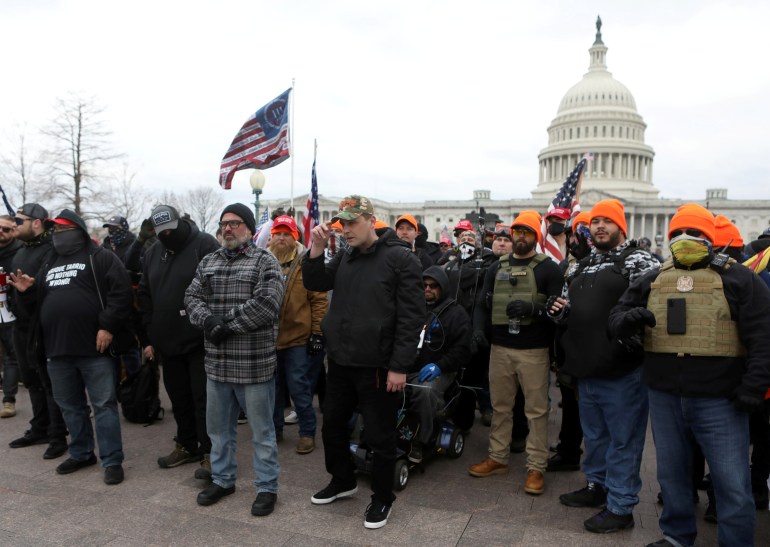Mistaken identity: FBI probe into Jan 6 rioters sees challenges
A woman’s claim FBI mistook her for another in their investigation, raises questions about the extensive investigation.

The investigation into the January 6 Capitol insurrection has challenged law enforcement, taking officers across thousands of miles and digital images, searching for rioters and stolen property, including US House Speaker Nancy Pelosi’s laptop.
“We’re looking for Nancy Pelosi’s laptop,” FBI agents told Marilyn Hueper on April 28 after briefly handcuffing her.
Keep reading
list of 3 itemsUS officer died of natural causes after Capitol riot: Coroner
Man who put feet on Pelosi’s desk during US Capitol riot released
Hueper told The Associated Press news agency: “That still doesn’t explain why you’re in my home. Or in Homer, Alaska.”
The agents walked out of Hueper’s home with iPads, mobile phones and a pocket-sized copy of the Declaration of Independence, the AP reported. They took a laptop, but it was not from Pelosi’s office. And it is possible they may have the wrong person altogether, Hueper claims.
Homer Residence Raided By FBI Wednesday
The home of Paul and Marilyn Hueper, the owners of the Homer Inn and Spa, was raided by FBI agents on Wednesday, April 28th. Through… – https://t.co/w4XaEu60Zl pic.twitter.com/Rb7ReXoowr
— KSRM Radio 92 (@ksrmam) April 30, 2021
Federal prosecutors have charged more than 400 people in relation to the riot, and expect to charge at least 100 more in one of the largest undertakings by the US Justice department in American history. The investigation has included scores of defendants who posted images and videos of their crimes online and boasted about breaking into the hallowed building.
These include far-right figures, conspiracy theorists and anti-government militias.
Some are facing serious charges and considerable prison time, including conspiracy. Reports suggest evidence is trending towards sedition charges for some, a serious charge rarely used by prosecutors.
But the Justice department’s far-reaching prosecution of those who stormed the US Capitol on January 6 has not been without its problems, including this potential instance of mistaken identity. And as Republicans increasingly seek to minimise the insurrection and play down the horror of the day, any missteps by federal prosecutors could be used in that effort to discredit what actually happened.
Evidence overload
The volume of people inside the Capitol building, along with the lack of arrests made at the time of the riot, has made it difficult to identify people, even with the glut of social media evidence.
Federal agents have dug through thousands of social media posts, gotten sweeping warrants to obtain information on mobile phones in the area of the Capitol, used facial recognition tools and obtained logs of devices that signed into the congressional WiFi during the riot.
But by far the most effective tool for federal agents has been old-fashioned tips. Many of the rioters have been identified by their friends and family members.

Hueper and her husband first came to officials’ attention this year when Alaska Airlines in February banned the couple for refusing to wear masks on a flight, according to court documents obtained by AP. Then two other people called in tips saying they recognised Hueper in photos that authorities had released of suspects wanted for storming the Capitol.
Riley June Williams, a Pennsylvania resident, was arrested in January after a tip that she took Pelosi’s laptop. Legal proceedings in the Williams case are ongoing, according to court documents seen by Al Jazeera.
The warrant, obtained by the AP, identifies Hueper as the woman who took the laptop.
Hueper insists they are wrong. She told the AP that another woman wearing her same coat and with a similar hairstyle was inside the Capitol during the insurrection, not her.
She admits she was in Washington, DC, for Trump’s rally that day but says she did not get any closer than 91 metres (100 yards) from the Capitol and spent part of the day being lost in an unfamiliar city.
She said agents showed her one photo of the woman inside the Capitol, and they looked so similar that Hueper wondered if someone had used photo-editing software to put her in the photograph.

The warrant details how FBI agents located an image showing Hueper wearing similar clothing in a photo on her husband’s Instagram account. It said Hueper’s husband had also posted photos of them near the Capitol.
Hueper said an agent came back with a different and larger photo of the woman, which showed the suspected thief wearing a black sweater with large white snowflakes on it. The agent asked where in the house they could locate the sweater.
Hueper insisted she was not inside the Capitol, and said the sweater was hideous.
Hueper said she grabbed the photo and held it next to her face, asking the female agent to look at both closely, “Me. Her. Me. Her,” she told the agent. Hueper said the agent grabbed the paper and walked off.
Hueper listed further differences. After insisting, Hueper was shown the front page of the warrant but not allowed to thoroughly read the document, she told the AP. She read it only after receiving a copy as the dozen or so agents and Capitol Police officers left.
Hueper said she has not heard back from federal authorities, nor have agents returned her laptop, two iPads, two mobile phones or the 50-cent pocket-sized Declaration of Independence booklet they confiscated.
She has not been arrested. Justice Department officials would say only that the investigation is ongoing.
But she decided to go public with her story, just in case.
“I better go online and protect myself before they call me in and make me this person,” she told the AP.